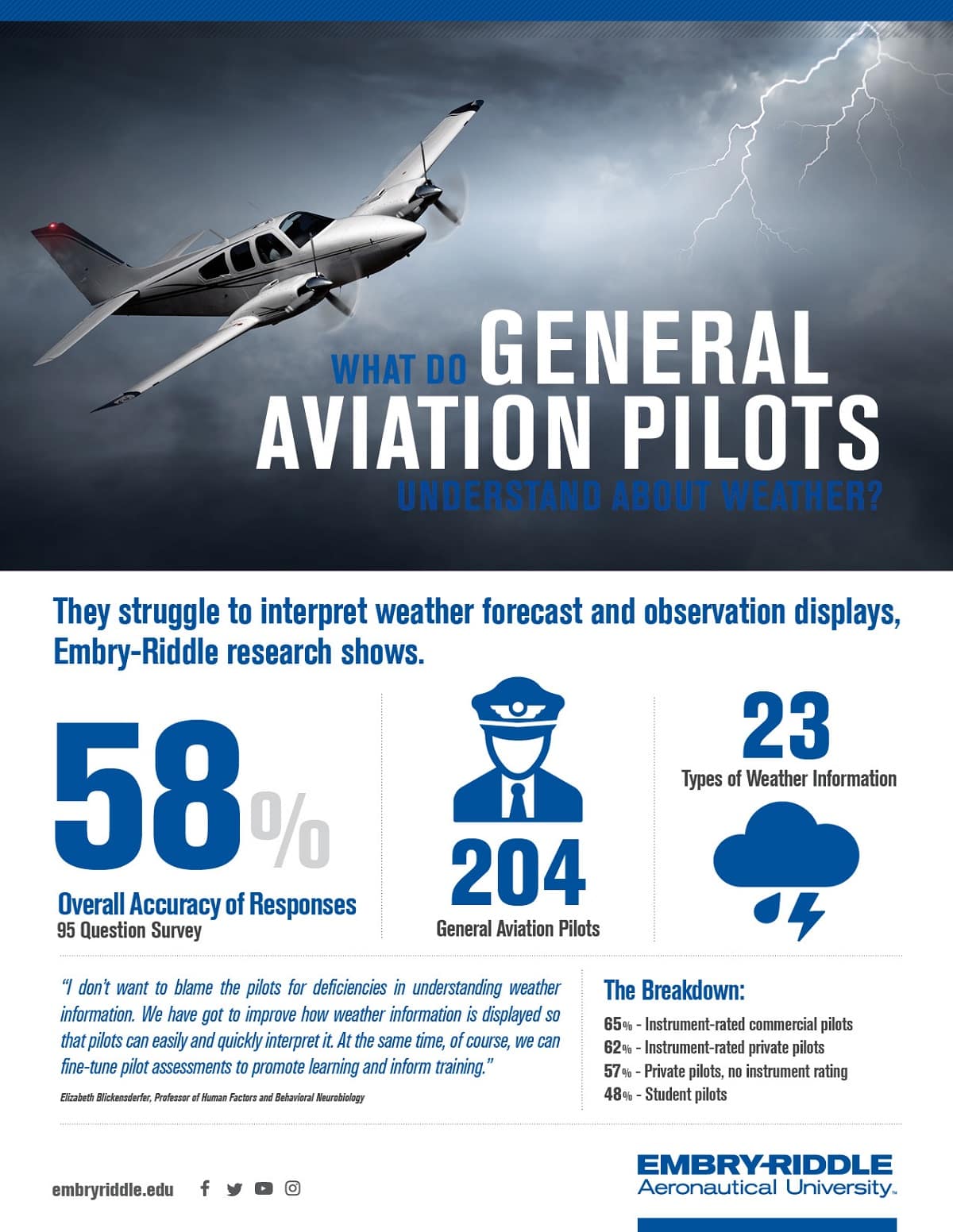General Aviation Pilots Need Improved Weather Displays, Research Suggests

When tested on their knowledge of 23 types of weather information, from icing forecasts and turbulence reports to radar, 204 general aviation (GA) pilots surveyed by Embry-Riddle Aeronautical University researchers were stumped by about 42% of the questions.
The findings, published in the April 2018 edition of the International Journal of Aerospace Psychology, are worrisome because GA pilots flying smaller planes at lower altitudes, usually with minimal ground-based support, have higher weather-related accident and fatality rates, said Embry-Riddle’s Elizabeth Blickensderfer, a professor in the Department of Human Factors and Behavioral Neurobiology.
Four categories of GA pilots who completed the 95-question exam scored as follows:
- instrument-rated commercial pilots achieved the highest scores, with a 65% accuracy level;
- instrument-rated private pilots ranked second, with 62% correct responses;
- private pilots flying without an instrument rating scored 57% and
- students correctly answered only 48% of the questions.
Overall, the mean score across all 204 pilots was 57.89%, based on assessments conducted on the university’s Daytona Beach, Fla., campus and at an air show in the midwestern United States.
Improved testing of GA pilots is needed, Blickensderfer said, noting that in 2014, the National Transportation Safety Board named “identifying and communicating hazardous weather” a top priority for improving safety. Currently, however, the U.S. Federal Aviation Administration’s Knowledge Exam allows pilots to pass even if they fail the weather portion of the test.

Weather Displays are Part of the Problem
She emphasized, however, that her research should not be interpreted solely as a symptom of faulty pilot training. “I don’t want to blame the pilots for deficiencies in understanding weather information,” she said. “We have got to improve how weather information is displayed so that pilots can easily and quickly interpret it. At the same time, of course, we can fine-tune pilot assessments to promote learning and inform training.”
What kinds of questions were asked on the survey?
As an example, respondents might be prompted to interpret cryptic METAR (Meteorological Terminal Aviation Routine Weather Report) information, which helps pilots prepare for safe flights: “You notice the comment, `CB DSNT N MOV N.’ Based on this information, which of the following is true?” Pilots should understand the METAR comment to mean, “Cumulonimbus clouds are more than 10 statute [land-measured] miles north of the airport and moving away from the airport.”
As another example, pilots might be asked to interpret a ground-based radar cockpit display, which would only show recent thunderstorm activity – not current conditions. Or, the survey might ask pilots to look at an infrared (color) satellite image and determine where the clouds with the highest-altitude clouds would most likely be found.
Thomas A. Guinn, an associate professor of meteorology at Embry-Riddle and a co-author on the study, noted that it’s critical for pilots to assess big-picture weather issues before takeoff. In addition, they need to understand, for instance, that radar displayed inside a cockpit shows what happened up to 15 minutes earlier.
“If you’re flying 120 miles per hour and you don’t understand that there’s a lag time in ground-based radar data reaching your cockpit,” Guinn noted, “that can be deadly.”
All test questions were designed to push pilots beyond whatever facts they had memorized, so that “they had to think about it and answer the question using the same thought processes as if they were performing a pre-flight check,” said Robert Thomas, another co-author of the study who is a Gold Seal Certified Flight Instructor and an assistant professor of aeronautical science at Embry-Riddle.
The research, supported by $491,000 in funding from the U.S. Federal Aviation Administration, could help guide pilot training and assessments. That’s important because pilots can actually pass the FAA’s existing Knowledge Exam even if they fail the weather portion of the test.
Blickensderfer, who is president-elect for Division 21 of the American Psychological Association and leader of the education division of the Human Factors and Ergonomic Society, co-authored her paper with Guinn, Thomas, students Jayde King and Yolanda Ortiz, and former Embry-Riddle faculty member John Lanicci, who is now at the University of South Alabama. Also on the research team were Nick Defilippis and Quirijn Berendschot
A follow-up study, involving about 1,000 GA pilots across the United States, is now underway.

 Ginger Pinholster
Ginger Pinholster